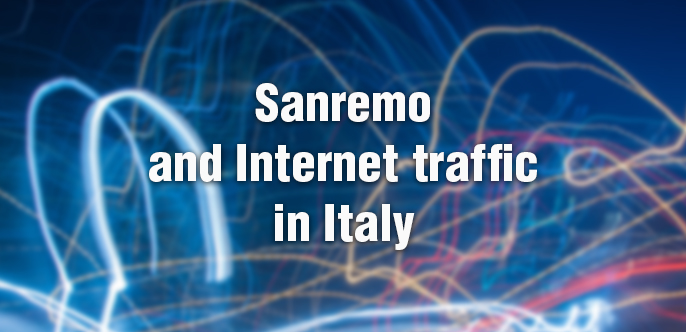Sanremo and Internet traffic in Italy from the perspective of an Internet eXchange Point
15/02/2024

By Flavio Luciani, Chief Technology Officer at Namex
The Sanremo Festival is the most important and prestigious music event in Italy. It’s an Italian song festival held annually in Sanremo, a city on the Ligurian coast. The festival was inaugurated in 1951 and has since become a staple for Italian music. The event is organized by RAI (Radiotelevisione Italiana), Italy’s main public broadcaster and is broadcast live throughout the country and in Eurovision.
The Sanremo Festival debuted in 1951 as a radio event. The first editions were broadcast on radio by RAI. In 1955, the Festival made its debut on television, while maintaining the radio broadcast. RAI held the exclusive rights to broadcast the festival on both radio and television. Despite the competition, RAI continued to hold the main broadcasting rights to the Sanremo Festival. However, agreements were made with private broadcasters to co-produce or broadcast side programmes related to the event.
It finally landed on RaiPlay (RAI’s streaming platform) in 2017. The platform was created in 2016 after a restyle of the Rai.tv website and has been available for smartTVs since December 2016.
But how much was this platform involved in the broadcast of Sanremo 2024?
First of all I would like to point out that the event was broadcast by RAI through both traditional TV and live streaming on RaiPlay. Usually, when an event is not broadcast exclusively on the Internet, traditional TV has the upper hand.
This has also been the case in past years, and looking at the Internet traffic of Namex (Sanremo 2022 and 2023) one can clearly see that the classic evening peak that usually reflects the use of entertainment services (whether on-demand or live streaming such as DAZN) is missing.


Let’s have a look at the trend for the entire week considering all Internet traffic generated in Italy. The Cloudflare radar graph helps me with this. The opening evening (Tuesday), the cover evening (Friday) and the final evening (Saturday) were the most viewed, and in fact the following graph clearly shows the difference between expected and real traffic.

Here is a zoom on Friday evening and Saturday’s final.

Still considering the three important evenings of the festival, let’s take a look at Namex traffic trends. Quantity and shape confirm the above with an increase in depression on the final evening of the event. In the graphs below, the blue line represents the expected traffic.

Opening evening (Tuesday)

Cover evening (Friday)
The Sanremo final is definitely the most viewed event. Saturday evening’s (missing) traffic was anticipated by a DAZN Roma – Inter match in which there was a significant peak in Internet traffic through Namex. This traffic then suddenly dropped for the start of Sanremo.

Saturday’s final
Seeing the whole week gives a more complete overview and gives a better idea of the difference in traffic.

It appears from the data collected that end-users prefer traditional TV to RaiPlay as well as they prefer the Sanremo festival to the usual evening entertainment offered by Netflix, Amazon Prime Video, and other platforms. Below is an example of one of these services at Namex with particular reference to the Sanremo evenings. It’s easy to spot the drop in Internet traffic during the evenings.

Rai, during the Sunday press review, has published interesting audience data related to the streaming platform RaiPlay showing that Saturday evening’s final was seen by around 800,000 people, an increase of about 126% compared to the 2023 edition where there were 353,000.
Thus, the number of people using the Internet for the enjoyment of content is increasing all the time. In Italy, the DAZN case (https://blog.apnic.net/2022/09/28/the-elephant-effect/) as well as the distribution of the UEFA Champions league are a clear example.
The shift from satellite to live streaming on the Internet is involving more and more services, but I think we should wait a few more years to have a complete model transition. Despite an undeniable transition to live streaming today (and who knows for how long) digital terrestrial and satellite are still the most used platforms for live events when broadcast ‘free to air’ on traditional television.
The views expressed by the authors of this blog are their own and do not necessarily reflect the views of LACNIC.